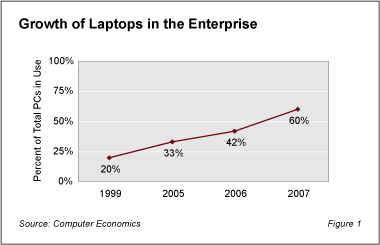Wireless connectivity has altered the business computing landscape forever. IT managers confronted with the demand for more mobile computing need to address issues as diverse as costs, security, resource allocation, and training. The technical staff will require new skills and knowledge to handle the unique requirements of mobile devices and their applications. Undoubtedly, changes in the network infrastructure will be necessary in order to respond to the capabilities of the next generation of mobile computers.
This Research Byte is an executive summary of our full report, Falling Costs of Mobile Computing Drive Corporate Adoption.
The most popular model for mobile computing today involves the integration of laptop (or, more accurately, notebook) computers with handheld devices. The laptop, however, is the primary component that IT organizations must deal with. Handheld personal digital assistants (PDAs) and smart phones are secondary devices to the laptop, and although they are highly popular devices, they will not play the central role in the mobile computing model over the next five years.
Market Changes Will Lower Prices
Computer Economics forecasts an increase in the ratio of laptops to desktops over the next two years, as shown in Figure 1. Laptops will outnumber desktops in most organizations by 2007, reaching 60% of the total personal computers in use in business computing. These conclusions are supported by most computer vendors who are gearing up to manufacture significantly more laptop systems. For example, the Lenovo Group, which bought out IBM’s PC division, expects that laptop shipments will exceed desktops by 2008.

Recognition of the marketing opportunity represented by mobile computing has all of the major personal computer vendors preparing new strategies to gain a competitive advantage. Perhaps the most interesting battle will be between Lenovo and Dell. Along with its buyout of IBM’s division, Lenovo inherited IBM’s sales and marketing channel partners along with some of its manufacturing plants. The cost burden of the sales channel and manufacturing facilities may make it difficult for Lenovo to counter the lower costs of Dell’s direct sales model and just-in-time supply chain. Lenovo is pegging its hopes on convincing buyers that its products are more innovative than Dell’s and will have more value over the long-term.
Business Reasons for the Switch
One of the primary drivers for the move to laptops are new work processes aimed at increasing business agility and profitability. Many employees are working from locations outside the company. Even for those that never leave the building, the value of easier collaboration makes laptops an attractive choice. The increased connectivity offered by wi-fi makes it possible for employees to have immediate access to information and to share it with colleagues, where ever they may be located.
Laptops also facilitate telecommuting. Not having to provide permanent office space for telecommuters reduces overhead. In addition, laptops and wireless networks eliminate the traditional expenses of rewiring when employees change offices. Finally, many laptop users consider them an additional company benefit, increasing employee loyalty and retention.
Procurement Costs Dropping, Support Costs Rising
Despite the advantages mentioned above, today there is still a cost premium for laptops in comparison to desktops. However, the cost difference between desktops and laptops is narrowing. The full version of this report shows the historical and projected cost differential between desktops and laptops, which indicates that by year end 2008, initial acquisition cost will be a non-factor in determining the deployment of laptops versus desktops. This narrowing cost differential, more than anything, is driving rapid adoption of laptops as a substitute for desktop computers for many business users.
While the initial system costs will soon be on par with their desktop counterparts, the support costs of laptops may increase for a while as companies adjust to a new support model. These new costs will most likely have an effect on the IT budget, and adjustments must be planned. The backing of upper management to deal with economic effects along with modifications in computer usage practices should be sought. With adequate preparation, mobile computing can lead to improved productivity and effectiveness.
December, 2005
This Research Byte is a summary for our full report, Falling Costs of Mobile Computing Drive Corporate Adoption, which includes historical trends and a projection of the cost differential of laptop computers to desktops through 2008. The full report is freely available to Computer Economics subscribers, or it may be purchased by non-subscribers at the following link: https://avasant.com/report/falling-costs-of-mobile-computing-drive-corporate-adoption-2005/




